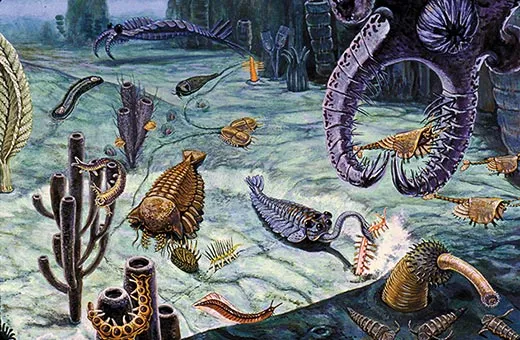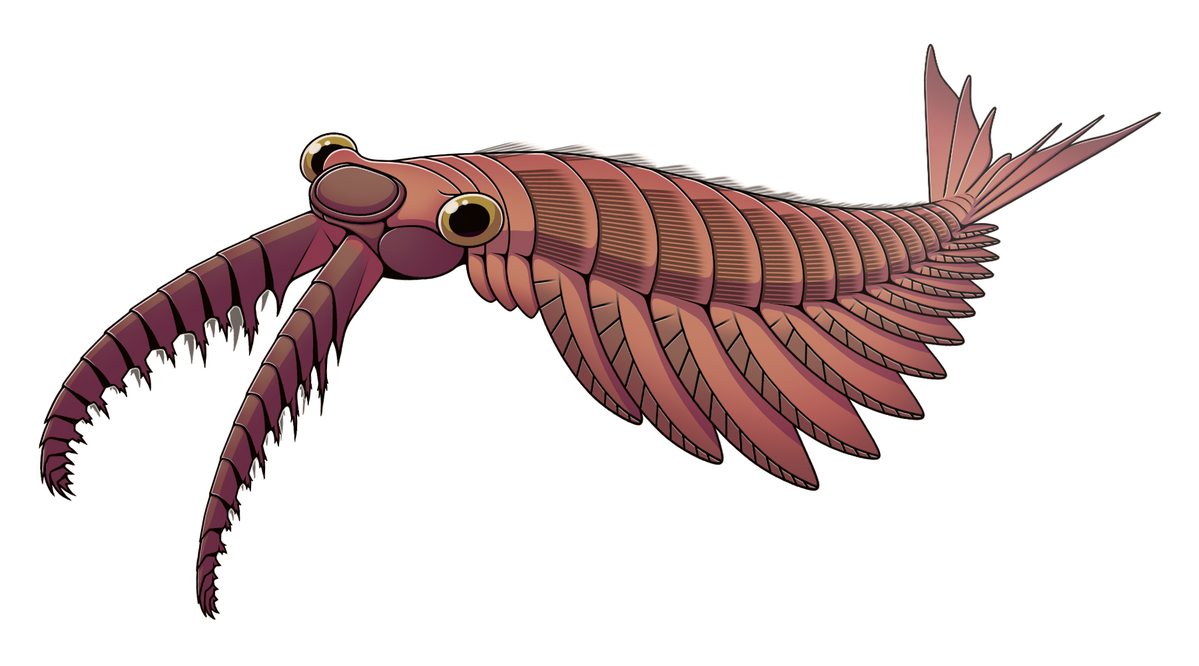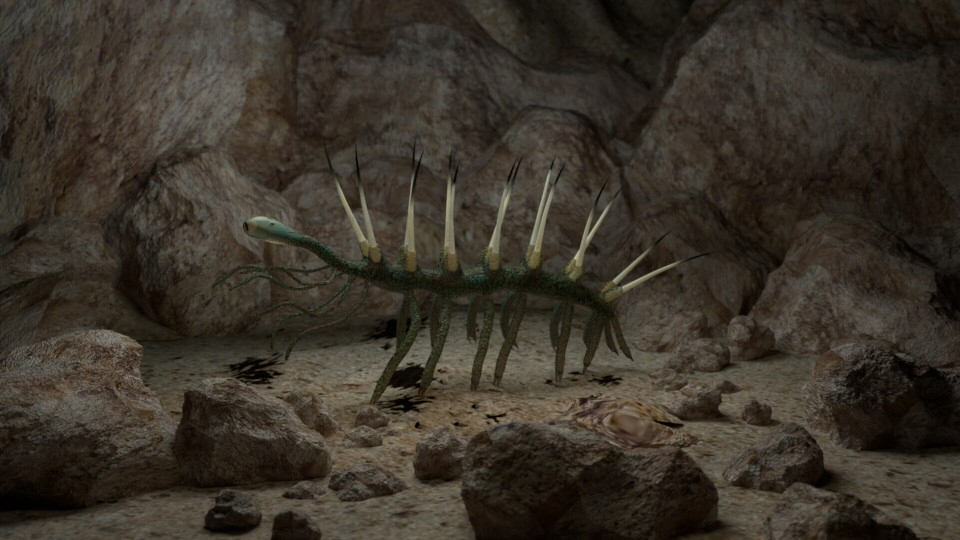
When discussing fossils and marine paleontology, it can be easy to forget about some of the earliest large animals to have swam in the oceans. Typically, after an animal dies, it’s body decomposes and the nutrients are returned to the ecosystem. Occasionally, this animal may be rapidly buried, and its body replaced by minerals during a process known as fossilization. In the grand scheme of geologic time, becoming a fossil is an extremely rare occurrence. This is multiplied by the fact that in general, the harder parts of the body such as teeth, bones, and shells will preserve much more easily than the soft integument and tissues. Given that marine organisms didn’t develop skeletons and shells right away, this poses a unique challenge in reconstructing ancient ecosystems. However, if given the right conditions, it is possible to find beautiful preserved fossils of soft bodied marine organisms.
Enter the Burgess Shale, an exposed geologic deposit from the Cambrian period nestled in the Canadian Rockies of British Columbia. It is one of the most famous and extensive examples of what is called a fossil lagerstätte, which is defined as a sedimentary deposit with a key characteristic of having exceptional preservation. The “Konservat-Lagerstätten” that is the Burgess Shale, which has readily preserved the soft tissue of 500 million year old animals, is likely the result of rapid burial in an anoxic environment with little bacteria in the way of decomposing the bodies. It is also a key piece of evidence in demonstrating the Cambrian Explosion, which is the idea that while the Pre-Cambrian era consisted of tiny and/or extremely simple organisms, there was an “explosion” of rapid diversification as these organisms evolved and diversified to fill in the niches of a marine ecosystem. The organisms represented in the Burgess Shale are some of the earliest examples of complex animals, and in a way, they can seem almost alien from a modern perspective, as many are from clades that have been extinct for hundreds of millions of years.
So what were the animals that once swam in this ancient marine environment? While there have been thousands of fossils recovered from this site since it’s discovery over a hundred years ago, some of the specimens uncovered have captured the imagination in the essence of how unique and ancient they are.
One of the most popular examples of a Burgess Shale resident is the Anomolacaris, a relatively large stem-group arthropod that was thought to have been the apex predator of the ecosystem. It had two large frontal appendages that could be seen as analogous to arms, which the animal used to grab its prey and bring it towards its mouth. Additionally, it’s thought that the eyesight of an Anomolacaris was much better compared to other creatures in the environment, which gave it a competitive edge in survival. This theory of feeding, combined with how utterly large it was compared to its Burgess Shale contemporaries, reaching a staggering 40cm, has led to the wide acceptance within the scientific community that Anomolacaris represents one of the first active hunting predators on Earth. As an arthropod, it would be most closely related to modern day horseshoe crabs, insects, and spiders.

Artist’s restoration of an Anomalocaris. (“Junnn11”, https://commons.wikimedia.org/wiki/File:20191203_Anomalocaris_canadensis.png)
Another quite unusual arthropod from this time was the Opabinia, a relatively understudied soft bodied animal. Strangely, the creature possessed five eyes, a backwards facing mouth underneath its head, and a clawed proboscis that was likely used for feeding. While originally thought to have been nothing like any of the known phylums, scientists today place it within the same group of stem-arthropods known as radiodonts, alongside animals such as Anomolacaris. It is thought that in life, the Opabinia would have scoured the ocean floor picking up small, soft bits of food with its proboscis and delivering it to its mouth. With such a strange appearance, it is a testament to how little is known about the earliest marine ecosystems, and what strange forms life can take on when given a blank canvas.

Life restoration of an Opabinia. (https://ocean.si.edu/through-time/ancient-seas/opabinia)
Another strange creature within the Burgess Shale is the Hallucigenia, which has confused science for decades through its history of inaccurate reconstructions. It is part of a group known as the lobopodians, which gave rise to modern day velvet worms and water bears. Morphologically, it is long and tubular, with around 10 pairs of legs referred to as lobopods. As an animal, it’s day to day life is still relatively unknown, given how few specimens there are and how understudied it is as an animal.

Artist’s interpretation of Hallucigenia (Jose Manuel Canete, https://upload.wikimedia.org/wikipedia/commons/8/83/H._sparsa.jpg)
Wiwaxia is another genus of animal discovered within the Burgess Shale. It is a soft bodied early mollusk that has carbonaceous plates and spines covering its body. It is likely that this armored covering was an early defense system against the large predators such as Anomolacaris, and it is thought that the animal moved across the sea floor raking food particles into its mouth. Additionally, it is thought that only the mature individuals of Wiwaxia would possess the large spines, while younger specimens would lack them until reaching adulthood.

Reconstruction of Wiwaxia. (https://burgess-shale.rom.on.ca/fossils/wiwaxia-corrugata/)
As it stands, the ecosystem of the Burgess Shale represents creatures that are unlike anything alive today, and was one of the most unique communities of animals in all of geologic history. The ocean is one of the greatest repositories for strange and unique organisms, and with the excellent preservational conditions of the Burgess Shale, it is hopeful that soon science will be able to catch more than a glimpse into this world that has been locked in time.
Featured image depicts an artists interpretation of what the Burgess Shale could have looked like. (Painting by D.W. Miller. Courtesy of Smithsonian Institution, https://www.smithsonianmag.com/history/burgess-shales-weird-wonders-36404411/)
Works Consulted:
Butterfield, N. J. (2003). Exceptional fossil preservation and the Cambrian explosion. Integrative and comparative biology, 43(1), 166-177.
Butterfield, N.J.; Balthasar, U.; Wilson, L.A. (2007). “Fossil Diagenesis in the Burgess Shale”. Palaeontology. 50 (3): 537–543.
Caron, J. B.; Jackson, D. A. (2008). “Paleoecology of the Greater Phyllopod Bed community, Burgess Shale”. Palaeogeography, Palaeoclimatology, Palaeoecology. 258 (3): 222–256.
Collins D (1996). “The “Evolution” of Anomalocaris and Its Classification in the Arthropod Class Dinocarida (nov.) and Order Radiodonta (nov.)”. Journal of Paleontology. 70 (2): 280–293.
Conway Morris, S. (1985). “The Middle Cambrian metazoan Wiwaxia corrugata (Matthew) from the Burgess Shale and Ogygopsis Shale, British Columbia, Canada”. Philosophical Transactions of the Royal Society of London B. 307 (1134): 507–582.
Shields, Graham (1998). “What are Lagerstätten”. Lethaia. 31 (2): 124.
Smith, M.R. (2014). “Ontogeny, morphology and taxonomy of the soft-bodied Cambrian ‘mollusc’ Wiwaxia”. Palaeontology. 57 (1): 215–229.
Whittington, H. B. (1975). “The enigmatic animal Opabinia regalis, Middle Cambrian Burgess Shale, British Columbia”. Philosophical Transactions of the Royal Society B. 271 (910): 1–43 271.